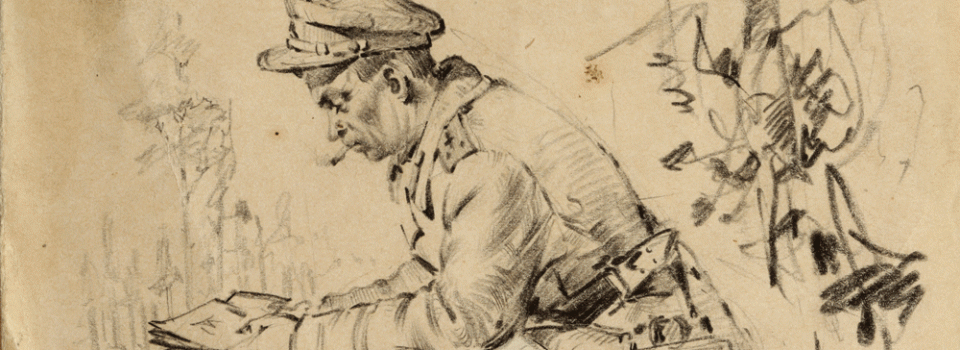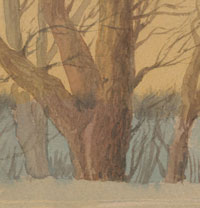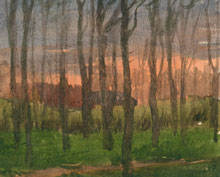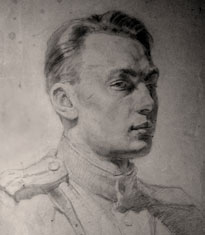“Everything was breathing such silence,
that it seemed the whole earth was still asleep.
Who knew that between this peace and war
There were barely five minutes left?”
“The Great Patriotic War, the most terrible of all wars known to mankind, started at dawn on June 22, 1941. Millions of people went to fight for their beloved Motherland, which was trampled by fascist invaders, to fight for the right to live and to love. At this time the third-year students of the Moscow Architectural Institute were at the monumental painting class. The war interrupted these studies. Without waiting for a draft order, like many students, I went to the recruitment office with one goal: to get to the front. In the early days of the war we, the students, were sent to the military personnel training courses at the Novgorod-Volyn Infantry School in Yaroslavl. After a 4-month military training I was given the rank of lieutenant.
November 1941 The country was in mortal danger, the enemy was advancing to Moscow. The 5th Moscow Volunteer Infantry Division was formed during the defense of Moscow (this division by the end of the war became known as the 158th Moscow Volunteer Liozno-Vitebsk, twice Red Banner, Order of Suvorov Infantry Division). The division, consisted mainly of intellectuals from Moscow, fought in Kalinin, Rzhev, Velikije Luky, Smolensk, Liozno, Vitebsk.
Kalinin Front The first fighting days were the hardest with inexperienced commanders and soldiers. Our 5th Moscow Volunteer Infantry Division was transferred by rail from Moscow to the Kalinin Front to the Kuvshinovo station, then we had a three-day march to the village of Selizharovo, then – to the outskirts of the village of Bezobrazovo, which was completely destroyed by the Germans, only burned chimneys were left standing. During the day marches, enemy reconnaissance planes (called “frames”) flew over our troops – they were certainly reporting the approach of our division, its size and the direction of our advancement. After this difficult march without rest or sleep the task of our two incomplete regiments, which were part of the 5th Moscow Mortar Division, was to take on Podsosenki village, then cut off one of the most important thoroughfares beyond this village. I remembered this first battle, the most horrific, for the rest of my life. We had to take Podsosenki, located on the river bank from the enemy. We stayed in Bezobrazovo, 1.5 km away. The German’s observation post was located in the village church of Holmets not far from Podsosenki. From that church on a hill the enemy could observe all the space around them. By order of the command, we launched an offensive in the early morning on a clear sunny day across a snowy flat valley with deep snow, without skis or camouflage gowns, without artillery or air support, which had lagged behind. They could see us as clearly as on the palm of a hand. Before we made a single step toward the enemy units, we were bombarded with mortars and artillery. Then we went on the offensive in this snowy valley, and the enemy, having sat on top, unleashed machine-gun and automatic fire on us. Our offensive got choked. We took cover in the bushes, in the shallow pits that we had hastily dug out in the snow, firing our rifles and machine guns at the enemy. The battle for the village of Podsosenki was cruel, the enemy showered us with artillery like a fire hurricane, machine-guns and dive bombers bombed us non-stop: one group is bombing, another flying, then they swap and do the same again and again. White field turned red-brown with blood and land mangled by shells. And so we were bombed into the night. We lost a lot of fighters. After this unsuccessful attack a few more than 20-30 people out of two incomplete infantry regiments survived. The soldiers, including myself, who miraculously survived this attack, gathered around one fire. When it got very dark, we began to pull our freezing and wounded soldiers from the battlefield under enemy fire. The Germans methodically shot long-range artillery guns, and the frost was ruthless. I pulled 5 wounded from the battlefield. The village was taken on the second night by a surprise attack of the 3rd Infantry Regiment, which was in the reserve of the Division Commander. In this battle I met Ivan Shatilov from another mortar battalion of our own 881st Infantry Regiment. We are still friends. He is a true noble friend and comrade, we often share thoughts about life.
On the second night we decided to attack the village to the left from Podsosenki. In this battle, our regiment was attacked by the Germans in the dark from the rear. We fought off the German attack with significant losses on both sides. At dawn our partially staffed infantry battalion, located near the barn between the village of Podsosenki occupied by our troops, and the village that our troops had to take, started the offensive. Due to the strong gale-like enemy fire (artillery, mortar and machine-gun) and the fact that once again we were attacking “head on” uphill, our attack failed and we lost many fighters. We found ourselves on a snowy hill in the daylight and were clearly visible to the enemy. The Germans killed everyone, and no matter how improbable it sounds, but I was the only survivor. I was lying in the snow among the dead and as soon as I’d start to move, I was shot at from a machine gun. The bullets hit the snow very close. I’d stay still – the shots would stop, but with the slightest movement machine-gun fire would return. I began to freeze, so I ran to the barn where the offensive began, our communicators were there. No one shot this time. And it is a mystery to me even now, why they did not shoot again. I alone survived this attack… Again at night, we attacked the village further to the left and captured it. Tired of night attacks, in the heated huts we ate and holding our battle stations, slept like logs. At night, just before dawn, there was a sudden attack by the Germans, with the support of artillery and aircraft. The enemy burst into the village, broke into our soldiers’ houses, and in a frenzy we were shooting at each other in the dark huts. Luckily, our brave gunners on the right flank cut off the chain of the attacking German soldiers. The enemy attack was fought off. In the dawn light we could see fleeing German soldiers. Now it was our turn to kill the retreating enemy, they suffered heavy losses. Our unit kept the conquered village. After that our division captured three more villages. With every battle our division gained experience of war fighting and for its numerous military services, received many awards. This experience came little by little with each fight through Kalinin, Rzhev, Velikye Luky, Smolensk, Liozno and Vitebsk. The division became combative and dangerous for the Germans; it was joined by professional military personnel – Siberians. At that time I was appointed Commander of a mortar company, we had 82 mm mortars and later 120 mm.
A few more memories. I was bringing the battle orders to the head regiment of our division. The enemy was retreating, it was hard to see at night where our troops were and where the enemy was. I walked carefully through the woods whilst listening to every sound. Safely reaching the village I found out where our front-line regiment was located. When I reached them, I passed the orders to the regimental commander and went back to the headquarters of my regiment. I was walking back through the woods without fear, as if there was no war. This carelessness almost cost me my life. Approaching the edge of the forest I saw a fire, only at twenty paces I realised there were German soldiers by the fire, about twenty-five of them. Turning sharply I ran back fast into the forest thicket, crunching twigs, hearing the whistling bullets, but the Germans did not pursue me, I reached my regiment alive and I had not been even wounded. I still sometimes dream that I’m facing the enemy alone on the edge of the forest, my legs turn to rubber and I cannot run away. Like many students of our institute I was well versed in map reading and land navigation, so I was often assigned tasks that required these skills. Once I had to direct a column of 12 T-34 tanks to the advance line. It was winter, the tanks were moving at high speed on rough roads with potholes and gullies. I sat on top of the leading tank, tightly hugging her main gun, and pointed the way for the tank column. I still don’t know how I managed to hold on and didn’t die then. When we started to approach the frontline, the column was targeted by anti-tank guns. Shells rained down like hail. I was a good target, but the German gunners aimed at the head tank. Reaching the command post I jumped off the tank and ran into the dugout to report to the regimental commander about our arrival. Somehow the German gunners managed to hit the first two tanks with anti-tank guns, which were rolled out close to the front. Our artillery and machine-gunners paid back – they destroyed these two anti-tank guns together with their crews. During this “duel” another ten tanks rolled into the ravine. A few hours later the general offensive of our division and our regiment began with the support of the tanks. The enemy was retreating on all fronts. Later the persistent and heavy fighting took place near Velikije Luky, Rzhev, Smolensk and Vitebsk. Veliukije Luky changed hands a few times.
Leningrad Front From 1944 I fought as a captain in the 178th Kulagin Red Banner Division on the Leningrad front, the combat history of which began in Leningrad and ended in Kurland. I was awarded the Order of the Red Star for taking part in the breaking and taking of the “Mannerheim Line” by our forces. I met again with Pavel Afonin during the fighting near Vyborg in 1944. The Army Corps of Engineers built a wooden bridge for our infantry to cross the river with guns and mortars to support the attack. In this battle Pavel was wounded by shrapnel from an enemy mine. When we met, blood was flowing down his face and onto his medals, and I said: “Pavel, I wish I could draw your portrait now, like Repin wrote his famous painting”. These words stayed with him all his life. We recalled our days in the Architectural Institute and dreamt to return there. The medics pulled out the splinter and bandaged Pavel’s head, then he stayed to fight with his assault team. In this brutal war I was lucky to meet with my friends from the Architectural Institute. When Major Rzhanitsyn, the Operations Assistant Chief of Staff of our regiment was wounded, I (mortar company commander at the time) temporarily became his deputy. Major Rzhanitsyn was a smart, highly skilled officer; we were friends so I learned a lot from him and knew how to act in his absence. Just at that time captain Schagen Airapetov, the combat engineer platoon commander, stepped into the dugout. Since I was seated against the light I saw and recognised Schagen, but he didn’t recognise me and started to report: “Comrade Operations Assistant Chief of Staff, on the orders of the command the reconnaissance company has arrived”. When he finally recognised me we hugged and kissed and started, once again, reminiscing about our beloved institute. With one reconnaissance scout killed, they captured a German who was taken to the division by the reconnaissance company. Once more I met with Shagen Ayrapetov when our division was on a short break on May 1, 1944.
We drank with him to the victorious homecoming. All through the war I went fighting with my friends. One of my best friends Alexander Pulym, a reconnaissance scout, who captured lots of Germans, was killed in 1943 – he did not return after one of his reconnaisance missions. Yuri Efimovich Pak, a former engineer company commander, later combat engineer battalion commander; after the war he worked at the Council of Ministers of the USSR; he died in 1985. Another close battle friend, Shagen Alexandrovich Airapetov, engineering platoon commander, then company commander; an architect after the war, he worked in the Central Research Institute of Standard and Experimental Designs of Medical Building. Sergeant Ivan S. Shatilov, who fought in the same division with me, the former rector of the Agricultural Academy named after Timirjazev, he worked in the Ministry of Agriculture, the Hero of Social labour, now retired. And my closest comrade and friend, Pavel Ivanovich Afonin, during the war he was the commander of the 17th separate assault field engineer brigade, in time of peace – the Head of the Department of Architectural Design at the Naval Academy in Leningrad, now retired. Our victory showed the greatness of Russia with many examples of selflessness and heroism by our people. But let there be peace, because it is wanted by all honest people of the earth. And we must not forget those who fought for peace, who stood the great test of life on earth, we must remember those who survived the war and worked side by side with us…”
Robert Rozhdestvensky:
“People!
As long as hearts are beating –
Remember
The cost of our happiness,
– Please remember!
Meet the tender spring,
People of the Earth,
Kill the war,
Damn the war,
People of the Earth!”
V.S. Atanov, 1990




